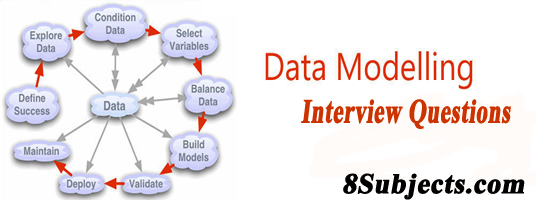It is the process of creating a data model for an information system. It is used to define and analyze data requirements needed to support the business process within the scope of corresponding information. Here are some best Data Modeling interview questions for experienced and freshers.
Data Modeling Interview Questions
1. What is Data Modeling?
The data model is a conceptual representation of Business Requirements (logic data model) or Data Base objects required for a database and is very powerful in expressing and communicating the business requirements and database objects.
2. What does the data model contain?
Logical Data Model Contain
Entry, Super Type, Sub Type, primary key, Alternate key, Inversion Key Entry, Rule, Relationship, Definition, Business Rule, Entity, etc.
Physical Data Model Contain
Table, Column, Primary key Constraint, Unique Index, Non-Unique Index, Check constraint, Default value, Foreign key, Comment, etc.
3. What is a Table (entity)?
- Data stored in a form of rows and columns is called a table.
- Each column has a data type and based on the situation, integrity constraints are enforced on columns.
4. What is a column (attribute)?
The column also known as the field is a vertical alignment of a data and constrains related to that columns.
5. What is a Row?
It is known as a tuple or record is the horizontal alignment of the data.
6. What is an index?
The index is imposed on a column or set of columns for the fastest retrieval of data.
7. What is a check constraint?
Check constraint is used to check the range of values in a column.
8. What is a unique constraint?
Unique constraint is imposed on the column data to avoid duplicate values, but it will contain NULL values.
9. What is a foreign key?
In relational databases, a foreign key is a field in one table which is used to uniquely identify a row of another table.
10. What are the important types of Relationships in a data model?
- Identifying
- Non – Identifying Relationship
- Self–Recursive Relationship
11. What is a sequence?
The sequence is a database object to generate a unique number.
12. What is cardinality?
In a database, high cardinality means more unique values are stored in a column and vice versa. One to One, One to many, and many to many are different types of cardinalities.
13. What is relational data modeling?
Visual representation of objects in a relational database is called relational data modeling, table contains rows and copies.
14. What are the basic elements of ERD?
- There are three basic elements
- Entities which we seek information
- Attributes the data collected about the entities.
- Relationships provide the structure needed to draw information from multiple entities.
15. What is a data model repository?
- A Data modeling repository is a storage area, where metadata of a data model is stored.
- The data is stored differently from the software perspective, organization’s perspective, and usage perspective.
- The repository can be stored any, either in a database or locally within any system.

16. What is De-Normalization?
- De- Normalization is a process of adding redundancy to the data.
- It helps us to quickly retrieve the information from the database.
17. What is OLTP data modeling?
- OLTP stands for online transactional processing.
- Data models constructed for transactions are called OLTP data modeling.
18. What is a constraint? And its types?
- The constraint is a rule imposed on data.
- Different types of constraints:
- Primary key
- Unique
- Not null
- Foreign key
- Composite foreign key
- Check constraint
19. What is reverse engineering in a data model?
- Reverse Engineering is a process useful for creating the data modes from databases and scripts.
- These tools have options to connect the database by which we can reverse engineer a database into a data model.
20. What is a composite foreign key constraint?
- The foreign key constraint is a column, that is used to establish and enforce a link between the data in two tables.
- It is defined as a constraint to create or modify a table.
21. What is a primary key constraint?
The primary key constraint is imposed on the column data to avoid null values and duplicate values.
22. What is a sequence?
It is a database object to generate a unique number
23. What is self – a recursive relationship?
A standalone column in a table that will be connected to the primary key of the same table. It is called a recursive relationship.
24. What is a composite foreign key constraint?
A group of columns in a foreign key, is called a composite foreign key constraint
25. What is forward engineering in a data model?
- It is a process by which DDL scripts are generated from the data model.
- Data modeling tools have options to create DDL Scripts by connecting with various databases.
- With its scripts and database can be created.